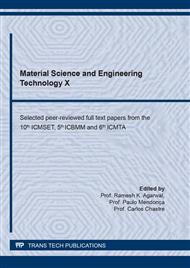p.9
p.16
p.22
p.29
p.35
p.41
p.47
p.55
p.61
Mechanical, Thermal and Morphological Properties of Poly(Lactic Acid) and Poly(Butylene Adipate-co-Terephthalate) Blends with Organoclay
Abstract:
This work studied the effect of nanoclay surface modified with 25-30 wt% of methyl dihydroxyethyl hydrogenated tallow ammonium (Clay-DHA) on morphological, mechanical and thermal properties of poly(lactic acid) (PLA) and poly(butylene adipate-co-terephthalate) (PBAT) blends. The PLA/PBAT (75/25 w/w) blends without and with Clay-DHA were melt mixed by an internal mixer and molded by compression method. The morphological analysis observed the phase separation of PLA/PBAT blends due to minor PBAT phase dispersed as spherical shape in PLA phase, indicating a poor interfacial adhesion between PLA and PBAT phases. The incorporation of Clay-DHA could improve the compatibility of polymer blends. The tensile testing found that the addition of Clay-DHA 1 and 3 phr increased Young’s modulus of PLA/PBAT blends. The addition of Clay-DHA decreased the strain at break of PLA/PBAT blends. The thermal degradation of PLA/PBAT blends and composites showed the similar thermal degradation process step. The addition of Clay-DHA was no effect on thermal stability and thermal properties of PLA/PBAT blends.
Info:
Periodical:
Pages:
35-40
Citation:
Online since:
February 2022
Price:
Сopyright:
© 2022 Trans Tech Publications Ltd. All Rights Reserved
Share:
Citation:


